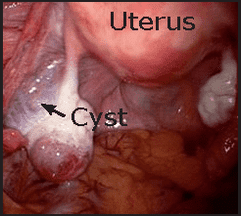 Pathophysiology Most Ovarian Cysts are small fluid-filled sacs that develop in a woman's ovaries as a normal part of a women’s menstrual cycle. During childbearing years a women produces a single egg once a month in a small sac called a follicle. The release of estrogen signals the sac to rupture and release the egg into the fallopian tube where it travels to the uterus. If the egg is fertilized, it implants on the uterine wall; unfertilized eggs are expelled with the uterine lining during menstruation. If the follicle fails to rupture and release the egg, fluid remains in the sac and a follicular cyst may form. Another type of cyst (corpus luteum cyst) can form even if the egg is released; this type of cyst contains a small amount of blood. Small cysts of either type—less than one half an inch—are common, produce no symptoms, and disappear on their own in a few weeks. A large cyst may cause pressure, bloating, pelvic pain, pain during intercourse if bumped, a increased desire to urinate, or a late period. Sudden and severe pelvic pain, often accompanied by nausea and vomiting, may be a sign of twisting of the ovary and reducing its blood supply or the rupture of a cyst and internal bleeding. If benign, the pain will improve dramatically within 45 minutes. Risk Factors
NOTE: the use of oral contraception decreases risk because it prevents the ovaries from producing an egg during ovulation. Signs & Symptoms
Treatment
Want more information on this and other wilderness medicine topics? Take one of our wilderness medicine courses. Guides and expedition leaders should consider taking our Wilderness First Responder course. Looking for a reliable field reference? Consider consider purchasing one of our print or digital handbooks; our digital handbook apps are available in English, Spanish, and Japanese. Updates are free for life. A digital SOAP note app is also available.
0 Comments
Your comment will be posted after it is approved.
Leave a Reply. |
Categories
All
Our public YouTube channel has educational and reference videos for many of the skills taught during our courses. Check it out!
|
 RSS Feed
RSS Feed
